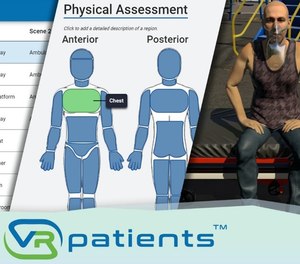Sponsored by VRpatients
By Margarita Birnbaum, EMS1 BrandFocus Staff
Online training software for first responders has come a long way since Karl Kellenberger became a paramedic almost two decades ago. Back then many programs didn’t give instructors options to tailor their lessons to their department needs.

But VRpatients stands out because the training platform allows instructors to create tailor-made clinical scenarios that give an accurate experience of what it’s like to assess, diagnose and treat a sick patient in real time. Together with textbook instruction, VRpatients’ lessons library and immersive experience assist instructors to more accurately evaluate students’ critical thinking skills.
“Anybody can put an IV tube in a mannequin or start one in an IV arm,” says Kellenberger, a rescue lieutenant with the Coral Springs, Florida Fire Department. “But do they know how to diagnose what they have and treat it?”
Since traditional classroom training has been scaled back to curb the spread of COVID-19, VRpatients has become an indispensable training tool for Kellenberger and other EMS instructors who had to adapt rapidly to teach online and give students the most realistic experience they could get.
Easy to build scenarios
With VRpatients, instructors can quickly set up lessons with menus that are easy to navigate to set up a variety of medical emergencies, the personal characteristics of patients, the locations of the calls, and other incident details.
For instance, educators can select the gender, age, and race of a patient. The medical conditions menu includes a large library of symptoms and diagnoses such as cardiac arrest, drug overdose and COVID-19. And educators can set up the incident at a park, an alley, or a bedroom, among many others.
In addition, instructors can set up the type of equipment they need to evaluate the patient’s vital signs, and the medications they need to give them.
Gives a real-world feel
Kellenberger, a firefighter and a paramedic, says VRpatients’ vivid scenarios are as close to the real deal as online training tools get.
Users can interact with the avatars the way first responders do with living patients. Instructors can program the avatars to respond to questions students ask them, such as ‘how are you feeling today?’ They can also program the virtual patients to follow instructions the students give them.
The virtual patients can also moan, clutch their chest, and behave similarly to sick human patients who have chest pains, dizziness and other symptoms. And just as in real life, when the first responder is treating the patient, the avatar’s physical appearance and vital signs change.
Even the incident locations are similar to the spaces first responders see on their day-to-day calls to people’s homes, city parks and other spaces.
A street scene in a downtown area, for instance, includes a construction cone, a bench, an advertisement and a trash can. In a dining room setting, you can see plates and a serving bowl on the table, family portraits and chipped paint on the walls.
Immersive experience
Then there’s the feature that takes VRpatients’ modules to the next level: the virtual reality aspect.
Now that students cannot spend time in fire houses and hospitals shadowing first responders, virtual reality is a critical teaching tool that creates the stress of often-critical situations – and tests the students’ ability to think on their feet.
“When they can actually attach emotions to the training, the students buy into it more,” said Kellenberger said. “The responses are as if it was a real patient – just nobody dies.”
You can also use the program without a VR headset because VRpatients is an interactive, web-based application that anyone with a computer can access.
Future of training
As online learning platforms evolve and offer more vivid interactive experiences, instructors will rely on programs such as VRpatients to teach new generations of first responders who may demand more virtual instruction. Looking ahead to when pandemic restrictions ease up, Kellenberger will continue to use VRpatients to complement his in-person training courses.
He suspects even veteran firefighters and medical personnel wedded to the conventional classroom setting will warm up to it and use it to keep their skills current. Many colleagues who are new to the program are surprised to learn that the situations are very true to what they’ve seen in their long careers.
“We have a lot of great instructors that can teach on a regular mannequin, and we have a lot of great instructors that can use computer-based programs,” he said. “I think we can embrace all of it and become better instructors and provide better training to our students.”
For more information, visit VRpatients.
Read next: Striking a balance between distance and in-person training
The Link LonkDecember 22, 2020 at 03:36AM
https://www.ems1.com/ems-products/online-training/articles/why-vrpatients-makes-training-easy-0gl3QgXGaPsq6y77/
Why VRpatients makes training easy - EMS1.com
https://news.google.com/search?q=easy&hl=en-US&gl=US&ceid=US:en
No comments:
Post a Comment